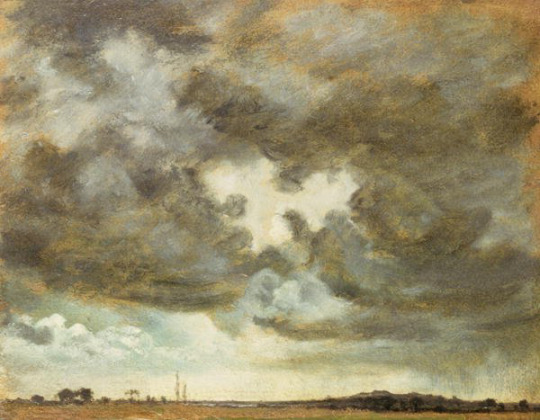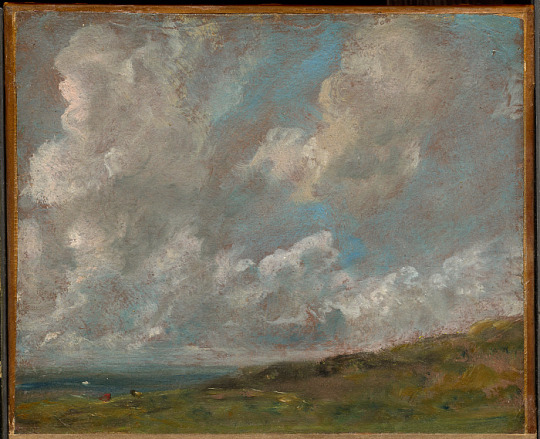Don't wanna be here? Send us removal request.
Text

“The passion caused by the great and sublime in nature… is Astonishment; and astonishment is that state of the soul, in which all its motions are suspended, with some degree of horror.”
— Edmund Burke
Constable, John. View in Wiltshire.
0 notes
Text

What makes this landscape sublime isn’t violence or grandeur—
it’s how ordinary it is, and still overwhelming.
Constable doesn’t dramatize the scene.
Instead, he gives the clouds full control of the sky,
their scale and volume dwarfing the land below.
You feel how heavy the air is. How far the horizon stretches.
There’s space—but not freedom.
There’s light—but no warmth.
This is the sublime through scale, atmosphere, and space.
It shows how nature can make you feel exposed without touching you.
How something as soft as a cloud can carry the weight of insignificance.
That’s the tension Constable captures:
the ordinary turned monumental.
Constable, John. Weymouth Bay: Bowleaze Cove and Jordon Hill. 1816. oil on canvas, 53 x 75 cm. Salting Bequest.
1 note
·
View note
Text

This sky is doing something that words can’t.
It doesn’t scream, but it looms.
It’s not violent, but it feels close to collapse.
Constable’s storm study doesn’t show a catastrophe—it shows the possibility of one. That tension, that unspoken threat, is where the sublime lives.
It’s in the scale of the sky dwarfing the figures below.
It’s in the way the clouds feel almost solid, like a wall of nature about to break.
It’s in the silence you feel just before something enormous happens.
This isn’t about beauty.
It’s about standing in front of something you can’t fully process—
and knowing it could destroy you if it wanted to.
That’s the sublime.
Not terror. Not awe. But the cold truth that you are small, and nature is not.
Constable, John. Coast scene with breaking cloud Sun. oil on canvas
2 notes
·
View notes
Text

Constable, John. Sunset study of Hampstead, looking towards Harrow.
22 notes
·
View notes
Text

Constable, John. A Cloud Study.
2 notes
·
View notes
Text

Constable, John. Study of Clouds over a Landscape. c.1821-22. oil on laminated cardboard, 24.4 × 29.5 cm. Sterling and Francine Clark Art Institute.
9 notes
·
View notes
Photo
do clouds evoke feelings of sublimity?


In the Air by Artem Chebokha
26K notes
·
View notes
Text

Constable, John. Seascape Study with Rain Cloud (Rainstorm over the Sea). c.1824-1828. oil on paper, 22.2 x 12.2 cm. Royal Academy of Arts.
10 notes
·
View notes
Text

Goya, Francisco. Fire at Night. 1793-1794. oil on canvas, 50 x 32 cm. Private Collection.
26 notes
·
View notes
Text

Edmund Burke once stated, 'Whatever is fitted in any sort to excite the ideas of pain, and danger, that is to say, whatever is in any sort terrible...is a source of the sublime.' I'm not sure it's as black and white as that—but when it comes to nature, it just might be.
Théodore Géricault gives us a harrowing depiction of the survivors of a French naval frigate (The Méduse), who were abandoned by high-ranking officers that fled on the few available lifeboats after unqualified leadership led to a shipwreck.
In this painting, we see the grisly conditions they endured for 13 days—it’s overwhelming. The chaotic pile of bodies stacked on the makeshift raft, the faces of death, desperation, struggle, and the faintest glimmer of hope—all evoke the kind of vast, powerful emotion that defines the sublime.
Here, the sublime isn’t just about beauty—it’s about being confronted with something beyond comprehension: the terrifying power of nature, the raw scale of human suffering, and the moral failure that caused it.
The violent, uncaring sea and sky remind us of our smallness. The emotional pyramid we’re guided through—from death to hope—and the injustice behind it all—that’s what makes this painting a true embodiment of the sublime.
Géricault, Théodore. The Raft of the Medusa. 1819. oil on canvas, 491 x 716 cm. Musée du Louvre ⎯ Paris, France.
#theodore gericault#romanticism#art history#painting#art analysis#the sublime#edmund burke#the raft of the medusa
25 notes
·
View notes
Text

Friedrich, Caspar David. Wanderer above the Sea of Fog. 1817. oil on canvas, 94.8 × 74.8 cm. The Met.
#sublime#caspar david friedrich#romanticism#19th century#aesthete#art#explore#painting#art history#artwork
21 notes
·
View notes
Text

Sublime
The sublime emerged as a powerful theme in Romantic art, but it was first introduced as a concept by Edmund Burke in 1757 in his work A Philosophical Enquiry into the Origin of our Ideas of the Sublime and Beautiful. He distinguishes the sublime from the beautiful, arguing that the sublime stems from experiences of vastness, terror, and awe that overwhelm the senses—while the beautiful evokes pleasure through harmony, delicacy, and proportion. These emotional responses, Burke claimed, are deeply rooted in human psychology and shape the way we experience art and nature. Artists like Géricault, Church, and many others turned to their canvases to portray scenes of astonishment, mortality, and existential dread.
Is the sublime responsible for the strongest emotion the mind is capable of feeling?
Church, Frederic E. Niagara Falls, from the American Side. 1867. oil on canvas, 257.50 x 227.30 cm. Scottish National Gallery.
3 notes
·
View notes
Text
felurya ===> SUBLIME (ROMANTICISM)
✌️
🔊NOW PLAYING:N MY FEELINGS— SEDDY HENDRIX🎧
0 notes
Text

“Distance” by Felurya – The final piece in this series marks an emotional shift: the once-close girl and rabbit now exist in separate spaces, with silence stretching between them. The girl stands alone, her face partially obscured, while the rabbit lingers in the mist—neither approaching nor retreating. The muted green palette and the enclosing forest create a sense of quiet isolation. More than just physical space, Distance captures the inevitable changes that pull people apart, whether by choice or by time. It is not a definitive farewell, but the space between one chapter and the next.
Felurya. Distance. Procreate.
@felurya
2 notes
·
View notes
Text

“Listener” by Felurya — In this third piece, the young girl’s gaze shifts directly toward the viewer, creating an intimate yet unsettling connection. Her expression feels guarded, perhaps quietly asking to be seen or understood. Seated across from her, the rabbit-masked figure remains stoic — a silent presence offering no guidance, only quiet observation. The table’s lone glass suggests this is her moment to reflect or speak, yet her gaze suggests she’s still holding something back. With its soft colors yet heavy emotional tone, this piece explores themes of silence, vulnerability, and the quiet weight of unspoken emotions.
Felurya. Listener. Procreate.
@felurya
5 notes
·
View notes
Text

“Leaving the Nest” by Felurya — The second piece in a haunting yet tender series. This time, the rabbit-masked figure leads the girl away from a warm, familiar home. The soft pastels of the house and blossoming tree create a sense of comfort, yet the dark presence of the cloaked figure hints that this departure isn’t without unease. The girl’s red scarf, a symbol of warmth or connection, suggests she’s carrying a piece of home with her — a reminder that growth often means leaving behind what’s safe. There’s a bittersweet tension in her expression, caught between holding on and moving forward. This piece beautifully captures the quiet, emotional weight of stepping into the unknown.
Felurya. Leaving the nest. soft pastel on paper.
@felurya
1 note
·
View note
Text

Felurya’s “the guide” is an evocative, narrative-rich piece that plays with surrealism and symbolism. The muted colors, expressive textures, and uncanny subject matter create a haunting yet poetic atmosphere, leaving room for personal interpretation. Whether seen as protective or ominous, the piece captures the delicate interplay between trust, fear, and the unknown paths we must follow.
I don’t think the rabbit has malicious intent towards the girl but rather is serving as her guide as she embarks on an unknown journey. Like the rabbit in Alice in Wonderland the girl follows the rabbit—but looks back, as if reluctant, afraid, or uncertain.
Felurya. the guide. April 8, 2024. soft pastel on paper. Brasil.
2 notes
·
View notes